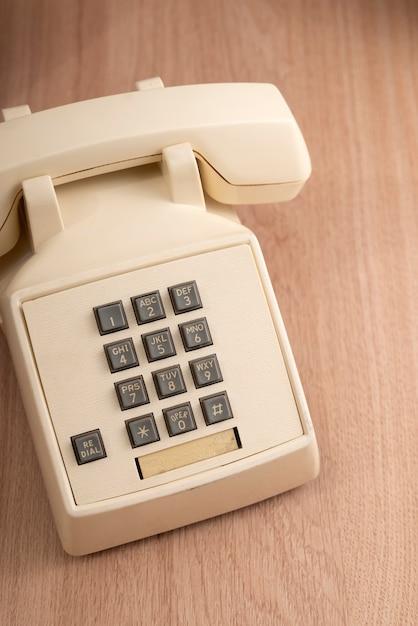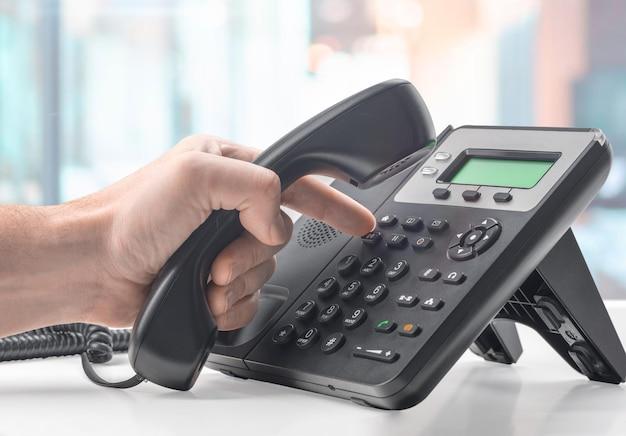As businesses grow, their communication needs evolve. One of the most critical business communication tools is the telephone system. Choosing the right telephone system can be tricky, especially when you’re not familiar with the technical jargon. Two major telephone systems you might come across while shopping for a business phone system are the Key System (KS) and the Private Branch Exchange (PBX).
In this comprehensive blog post, we’ll take a closer look at these two systems and the types of businesses they’re best suited for. We’ll also explore the differences between KS and PBX systems, including their functionality, cost, and features. By the end of this post, you’ll be well informed on which telephone system is suitable for your business needs.
But, before we dive into the differences between KS and PBX systems, let’s define them.
What is a PBX System
A Private Branch Exchange (PBX) is a centralized telephone system that connects internal communication lines within an organization. This type of system gives businesses the flexibility to manage multiple phone lines and extensions. PBX systems can also handle incoming and outgoing calls, routing them to the right person or department.
What is a Key System
A Key System (KS) is a multi-line telephone system that can support up to 40 lines and extensions. KS systems are prevalent in small businesses that require less complex features. These phone systems usually come with a control unit (KSU) that provides basic call handling capabilities. A KSU typically has buttons or keys, each representing a phone line, which users can select to make or answer a call.
Now that we’ve defined KS and PBX let’s dig deeper into their differences and similarities in terms of functionality, cost, and features.
Key System vs PBX: Which is Right for Your Business
Making the jump from a traditional phone system to a cloud-based service can be daunting, but it comes with many benefits. Business owners are often faced with the dilemma of choosing between a key system and PBX. Both systems offer unique features and benefits that can cater to the needs of your organization.
Key System
A key system is a telephone system that allows users to directly connect to one another on a single network. This system is generally used in small to medium-sized businesses that require fewer than 50 phones. The key system is easy to use and manage, and it is also cost-effective. With a key system, you have total control over your phone system.
PBX
PBX is short for Private Branch Exchange. It is a telephone system that connects internal phone lines to external phone lines and offers a range of features such as voicemail, call forwarding, and conference calling. PBX is best suited for larger organizations that require more than 50 phones. This system is more complex than the key network, but it offers more advanced features.
Key System vs PBX: Choosing the Right System
When choosing the right system for your business, it’s important to consider the size of your organization, your budget, and the features that you require. If you’re a small to medium-sized business with fewer than 50 phones, a key system may be the right choice for you. This system is easy to use and maintain, and it is also cost-effective.
For larger organizations that require more than 50 phones, a PBX system is the better choice. PBX is more advanced and offers a range of features that can provide a complete communication solution for your organization. PBX is also highly scalable, so it can grow with your business.
In conclusion, both key systems and PBX systems have their strengths and weaknesses. It’s important to choose a system that meets the specific needs of your organization. When making your decision, consider the size of your organization, your budget, and the features that you require. With the right system in place, your organization can enjoy seamless and efficient communication.
What Is A PBX System
If you run a business, you need an effective communication system to connect with customers and employees. A PBX system is the cornerstone of modern business communications.
Understanding PBX
PBX (Private Branch Exchange) is a telephone system that allows you to manage incoming and outgoing calls in an organization or business. It lets you create an internal communication network, which allows you to connect with employees and departments within your organization.
A PBX system consists of a control unit and several telephone lines. The unit manages all incoming and outgoing calls, as well as the distribution of calls to different telephones. With a PBX system, you don’t need to have a separate phone line for every employee or department in your organization. Instead, the PBX system enables all employees to share a few external lines and create an internal network driven by the telephone system.
Types of PBX
There are two types of PBX systems — the traditional analog PBX and the more recent digital PBX.
The traditional analog PBX system is a physical system that consists of hardware infrastructure and requires a specific location on your premises. It requires an on-premise telecom closet to hold the hardware PBX device, and all phone lines need to be routed through this device.
A digital PBX system, on the other hand, is a software-based system that can be hosted in-house or in the cloud. It offers more features than traditional PBX, including internet faxing, video conferencing, voicemail, and automated attendants, to name a few. Digital PBX system is much easier to manage, and since they’re not a physical system, they’re much more flexible than traditional PBX systems.
How a PBX System Works
A PBX system works by establishing a connection between two telephones. When you make a call, your PBX system manages the process by verifying the number and routing the call to the correct recipient on the internal network. PBX system also handles the transfer of the call to another person if necessary.
PBX systems are easy to use and save organizations from the hassle of managing phone lines and routing calls manually. With PBX technology, businesses can conduct their daily operations effectively and efficiently.
In Conclusion, PBX systems are an essential component of modern business communication, enabling companies to create an internal communication network and manage incoming and outgoing calls efficiently. Whether it’s a traditional analog PBX system or a digital PBX, you’ll find that having such a system in place will save you time, money, and hassle when it comes to business communication.
What is a Key System
A key system is a type of telephone system that uses physical buttons or keys to connect calls between internal stations and with outside lines. It is popular among small and medium-sized businesses because it is easy to use and maintain.
The Basics
In a key system, each phone has its own key set or multiple buttons on the phone to select and place a call on hold or transfer it to another line. A key system uses a “line appearance” model where each active line is assigned to a specific key, making it easy to manage call-routing and monitor call usage.
Key System Features
Key systems offer useful features such as call transfer, call hold, and intercom paging that make communication within the office more efficient. Additionally, most key systems allow for conference calling, which is beneficial for team meetings or large gatherings.
Key System vs. PBX
While key systems and PBX (Private Branch Exchange) systems share similarities, the main difference is in their scalability. Key systems are suitable for small to medium-sized businesses, whereas PBX systems are designed to support larger enterprises. PBX systems also offer more advanced features and customization options than key systems, making them suitable for businesses with more complex communication needs.
Key systems continue to be popular among small businesses, thanks to their simplicity and ease of use. Understanding the basics and features of a key system is vital in determining if it will meet your business needs. Even though PBX systems offer a range of benefits and more advanced features, they may not be financially viable for all businesses, especially startups.
Key Telephone System Example
A key telephone system, also known as a key system, is a type of telephone system used in small businesses or residences. They were popular in the past, but their usage has declined since the advent of Private Branch Exchange (PBX) systems. In this subsection, we’ll discuss an example of a key telephone system.
How It Works
A key telephone system consists of several stations or telephones. Each telephone has several buttons labeled with numbers, which correspond to other stations. For instance, if you want to call someone on line 3, you would press the button labeled ‘3.’ If that person is not available, you can press the ‘hold’ button and switch to another line.
A Real Example
Let’s take a dental office as an example. The front desk has a key telephone system with five stations, including one for the receptionist, one for billing, one for the manager, and two for the assistants. Each station has up to ten buttons that allow for up to nine other stations to be easily reached if needed.
Most key telephone systems also allow callers to be put on hold and transfer calls without the need for an operator. This way, the front desk can handle multiple calls at once without any delays.
Advantages and Disadvantages
One advantage of key telephone systems is that they are generally cheaper than PBX systems. They are simple to set up and maintain and don’t require a dedicated operator. However, key systems can become cluttered, which can make it challenging to keep track of lines. They are also limited in the number of lines and stations they can handle.
We hope this example has given you an idea of how a key telephone system works. Although they are less common today, they can still be useful in small businesses or residences with fewer phone lines. Remember that key systems are only suitable for smaller organizations and are not scalable in the long run. In the next subsection, we’ll compare key systems with PBX systems and determine the best choice for your business.
What are the three types of PBX
If you’re looking for a phone system for your business, you may have come across the terms “PBX” or “key system.” Both are phone systems that allow multiple lines to be shared between phones, but they differ in their features and capabilities. However, did you know that there are three types of PBX? Let’s take a closer look at each one.
Traditional PBX
Traditional PBX, also known as analog PBX, is the oldest type of PBX. It uses physical hardware and copper wiring to connect phone lines. Traditional PBX is reliable and can handle a large volume of calls, but it can be expensive to maintain and upgrade. As technology advances, traditional PBX systems are becoming less common.
IP PBX
IP PBX, also known as VoIP PBX, is a PBX system that works over the internet protocol network. It uses software to connect phones and allows for more advanced features like video calling and call routing. IP PBX is less expensive than traditional PBX and easier to maintain, but it requires a strong internet connection and can be vulnerable to security breaches.
Hosted PBX
Hosted PBX, also known as cloud PBX, is a PBX system that is hosted off-site by a third-party provider. It uses software to connect phones and is accessible through the internet. Hosted PBX is the most flexible and scalable type of PBX and requires minimal hardware and maintenance. However, it relies heavily on the quality of the internet connection and may be more expensive in the long run due to monthly subscription fees.
In conclusion, there are three types of PBX: traditional PBX, IP PBX, and hosted PBX. Each has its pros and cons, so it’s essential to choose the one that fits your business’s needs and budget.
What is the difference between KSU and PBX
If you’re new to telephony, two terms you’ll hear frequently are “KSU” and “PBX.” While they may seem interchangeable, there are some differences between them.
KSU
KSU stands for “key system unit.” A KSU is a telephone system that is designed for small to medium-sized businesses. It typically serves up to 40 stations and is limited in its capabilities. KSUs are often used by businesses that do not need a lot of phone lines.
One of the main features of a KSU is the presence of keys designated for each line. Each phone unit in the office has its own key, and users can easily see which lines are in use. KSUs may also come equipped with basic call management features, such as call forwarding and call waiting.
PBX
PBX, on the other hand, stands for “private branch exchange.” A PBX is a larger telephone system that is designed for larger businesses or corporations. A PBX serves a large number of phone lines, and it can be equipped with many features.
One of the most significant differences between a KSU and a PBX is that a PBX is much more scalable than a KSU. A PBX can handle more phone lines, and it can be expanded as needed. PBX systems are also designed to handle complex call routing and management, which is valuable for businesses with a high volume of calls.
Another key difference between a KSU and a PBX is that a PBX can be integrated with other communication systems, such as email, video conferencing, and instant messaging. This makes it a more comprehensive solution for businesses that need a range of communication tools.
In summary, the primary differences between a KSU and a PBX are the size of the system and the capabilities. KSUs are ideal for small to medium-sized businesses that need a basic telephone system, while PBXs are more suitable for larger companies that require a more comprehensive communication solution. Whichever system you choose, be sure to consider your business’s current needs and future growth potential.
Type of Central Office Line Preferred for Most PBX Systems
When it comes to choosing the appropriate central office line for your PBX system, you have a few options to consider. Each type of line has its own unique features and benefits that can be customized to perfectly fit your business needs. Here, we will discuss the most popular types of lines used for PBX systems and what makes them a top choice for businesses.
Analog Lines
Analog lines are the most basic type of lines and have been in use for many years. They operate using traditional copper wires and communicate voice messages in an analog format. Analog lines are also known as Plain Old Telephone Service (POTS) lines and are still used by many businesses today.
Digital Lines
Digital lines, on the other hand, operate using digital technology. They transmit voice messages in digital format, providing better voice quality and clarity. Digital lines are also known for their enhanced features and services such as call forwarding, caller ID, and voicemail. Digital lines are recommended if your business requires high quality voice calls.
VoIP Lines
VoIP lines use the internet to make and receive calls. They convert voice data into digital packets, making communication more efficient and cost-effective. VoIP lines are the most popular choice for businesses transitioning from traditional PBX systems to more modern systems.
SIP Trunks
SIP trunks, or Session Initiation Protocol trunks, are another type of central office line that are becoming increasingly popular. They use internet protocol (IP) to connect the PBX system to the public switched telephone network (PSTN). SIP trunks offer superior voice quality and reliability compared to other lines.
In conclusion, the type of central office line you choose for your PBX system must depend on the specific needs of your business. Consider your budget, the desired features of your PBX, and the type of communication that your business engages in. By carefully selecting the right line, you can ensure an efficient and cost-effective communication system for your business.
Intercom Button: A Common Feature in Phone Systems
When it comes to phone systems, one feature that you might have encountered in most offices is the Intercom button. So, what is an intercom button precisely, and what are its uses?
Defining Intercom Button in a Phone System
An intercom button is a feature available in most office phones that permits communication between phones in the workplace. This feature is usually activated by pressing the intercom button on the phone, followed by the extension of the person you wish to communicate with.
Uses of Intercom Buttons in Phone Systems
-
Paging: Intercom buttons are commonly used for paging announcements throughout the workplace, which is useful in large office spaces.
-
Quick Communication: Using an intercom button to contact someone in the office is much faster than walking over to their desk or sending them an email.
-
Meetings: Intercom buttons come in handy during meetings, where one can easily call a colleague via phone without having to walk up to them.
-
Emergency Situations: In case of emergencies such as fire or security threats, intercom buttons can be used to quickly communicate with all employees in the building at once.
Types of Phone Systems with Intercom Buttons
Intercom buttons can usually be found on both Key Systems and PBX (Private Branch Exchange) phone systems. However, the location of the intercom button differs between the two.
- In Key Systems, intercom buttons can usually be located on the phone’s keypad.
- In PBX Systems, intercom buttons are usually integrated into the phone’s handset.
An intercom button is undoubtedly a handy feature in most phone systems, especially in large offices with several departments. It saves time and enables quick communication while also being useful in emergencies. Whether your office uses a Key System or a PBX System, an intercom button is typically available in both systems.
One of the Features That Makes Key Systems Different From Traditional PBX Telephone Systems
When it comes to phone systems, there are two main types: the traditional PBX telephone system and the key system. While they may seem similar at first glance, there are some features that make key systems stand out from their PBX counterparts. One of these features is the ability to have individual buttons for each line.
Individual Buttons for Each Line
In a traditional PBX system, there are typically several incoming phone lines that are shared among all the users. This means that if multiple people want to answer different lines, they need to coordinate with each other, which can be confusing and inefficient.
In contrast, a key system has individual buttons for each line, which allows users to see which lines are in use and pick up the one they want to answer. This makes it much easier and faster for everyone to manage calls, and it also reduces the chances of callers being put on hold unnecessarily.
Flexible Call Handling
Another advantage of key systems is that they offer more flexibility when it comes to call handling. For example, in a PBX system, calls may need to be transferred to a specific extension, which can be time-consuming and frustrating if the caller gets lost in the transfer maze.
With a key system, however, users can simply press a button to transfer a call to a specific person or department. This makes it easier for everyone to manage calls and ensures that callers can get the help they need quickly and efficiently.
While there are many similarities between key systems and traditional PBX telephone systems, it’s important to understand the features that make them different. By having individual buttons for each line and offering more flexible call handling, key systems can help businesses improve their communication and provide better customer service.
An Advantage of an Electronic Key System Over a Conventional Key System is Convenience
Electronic key systems are becoming increasingly popular, and it’s no surprise why. They offer many advantages over traditional systems, the most important of which is convenience. Here are some of the ways an electronic key system can make your life easier:
No Need to Carry Many Keys
One of the most significant advantages of an electronic key system is that it eliminates the need to carry many keys. Instead, you get a single key, which you can use to access all the doors that you are authorized to open. This makes it a lot easier to manage your keys, and also reduces the chance of losing them.
24/7 Access to Facilities
With an electronic key system, you can access the facilities you need at any time of the day or night. This is particularly useful if you work late hours or if you need to access your workplace during weekends or holidays. You won’t have to worry about finding someone to let you in. You’ll have access whenever you need it.
Reduced Risk of Break-Ins
Electronic key systems are more secure than conventional systems. They use advanced encryption technology to protect against copying and manipulation, reducing the risk of break-ins. Also, if a key is lost or stolen, it can be invalidated quickly, rendering it useless.
Remote Access Control
Another advantage of an electronic key system is remote access control. With a conventional key system, you need to be physically present to grant access to someone. With an electronic key system, you can grant or revoke access remotely. This may come in handy when you are not in the office, but someone needs to access your facilities.
Ease of Maintenance
Finally, electronic key systems are much easier to maintain than traditional systems. The infrastructure can be easily integrated with other security systems, and the software can be updated remotely. There is no need for manual rekeying, which can be time-consuming and costly.
In conclusion, electronic key systems are more convenient than conventional systems, with benefits such as reduced need to carry many keys, 24/7 access to facilities, reduced break-in risk, remote access control, and ease of maintenance. If you need a secure, reliable, and user-friendly key system, an electronic key system is the way to go.



